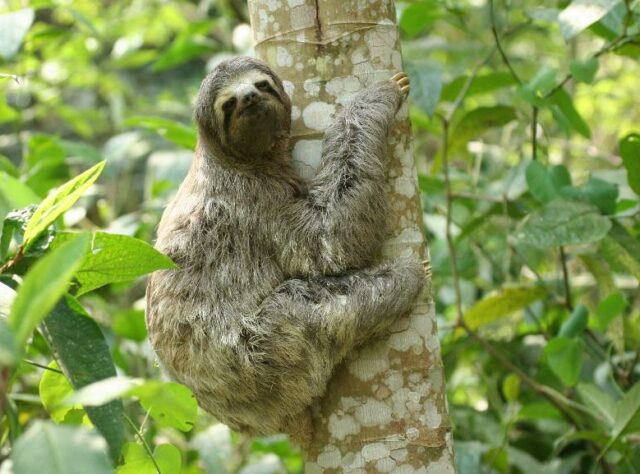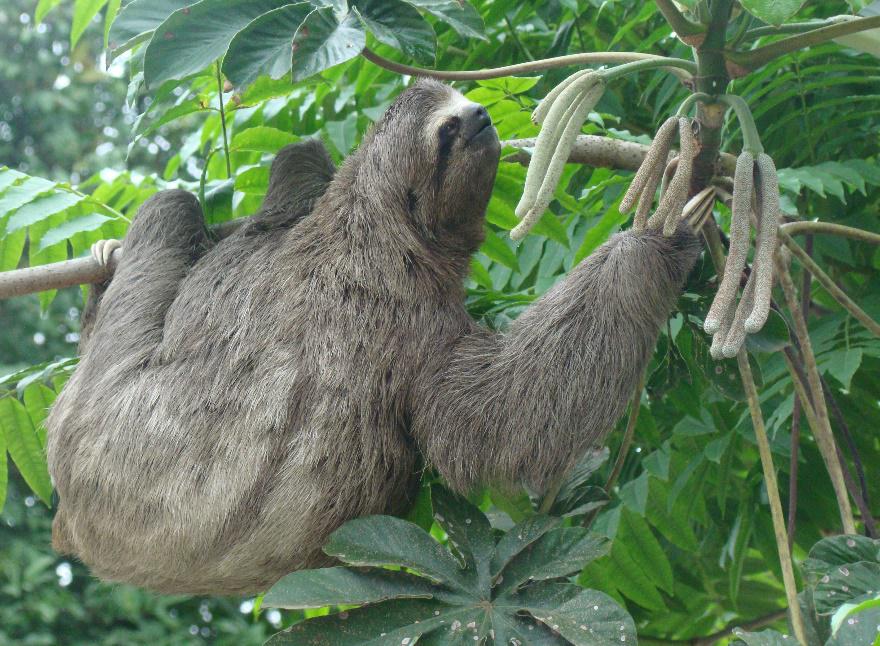
By Lee Dingain – UK representative for REGUA.
After nearly 20 years conserving the Atlantic Forest at the Guapiaçu Ecological Reserve (REGUA) in south-east Brazil, much of the biodiversity that calls this forest their home is steadily recovering. One of the most charismatic animals benefiting from protection at REGUA is the Brown-throated Sloth (Bradypus variegatus).
A decade or so ago, these rather bizarre looking canopy dwellers were a less frequent sight at the reserve than they are today. Although Brown-throated Sloths are mainly diurnal, their arboreal lifestyle and habit of sleeping up to 20 hours a day, can make them difficult to spot, and before the reforested areas at REGUA had become established, reaching suitable sloth habitat invariably involved going on a hike. Nowadays, with more of the forest in the lowlands restored and hunting pressure greatly reduced, they are doing well at REGUA and so easier to find. Often one or two can even be found hanging out in the trees around the office!

A female Brown-throated Sloth reaching for cecropia leaves, one of their favourite foods. REGUA, Brazil.©Nicholas Locke
Modern sloths are found only in the Neotropics. The Brown-throated Sloth is the most widespread, ranging throughout the northern half of the Atlantic Forest, across much of the Amazon basin, and into southern Central America. There are two extant sloth families, the Bradypodidae or three-toed sloths, and the Choloepodidae, the two-toed sloths. The Brown-throated Sloth belongs to the former.
All species are arboreal herbivores, a lifestyle that is exceptionally rare amongst mammals, with just 10 species (or 0.2 percent) of mammals being tree dwelling vegetarians. While two-toed sloths include fruits and some animal matter as well as leaves in their diet, Brown-throated Sloths, like all other three-toed sloths, are strictly folivorous, and specialise in eating the leaves of just a few tree species, especially those of the genus Cecropia. To break down such a fibrous diet, three-toed sloths have the slowest digestion rate of all mammals and the lowest metabolism of any mammal not hibernating. They even partly control their body temperature by sunbathing and controlling their metabolism, and as result are the world’s slowest mammal.

Brown-throated Sloths on the ground are extremely vulnerable to predators. ©Alan Martin
Like all three-toed species, the Brown-throated Sloth has the most bizarre toilet habits. About once a week they descend from the canopy to the base of the same tree to defecate in a small hollow created using their tiny tail, ascending only after taking the time to cover the latrine. Over half of all adult sloth mortalities occur on or near the ground, so the reason why three-toed sloths (their two-toed relatives often poop from the canopy) would bother with such a risky and energetically demanding behaviour is not only baffling but also uncertain. Hypotheses include to communicate with other sloths, fertilise favourite trees within their territory, and even to maintain a symbiotic relationship with a type of moth.
The slow-paced lifestyle adopted by sloths has allowed a mini mobile ecosystem to evolve in their coarse outer layer of fur. The fur supports a range of symbiotic organisms, including fungi and, especially, green algae. The algae not only provide camouflage but are also a food source to a whole range of insects, including five species of pyralid moths found exclusively on sloth fur. The female moths lay their eggs in the dung deposited by the sloths, and emerging adults fly up onto the sloth’s fur during their toilet break. When the adult moths die, their bodies decompose in the fur, providing nutrients for algal growth. The sloths ingest the algae, supplementing their nutrient poor diet.

A Brown-throated Sloth awaiting release at REGUA, after being rescued from a road. ©Alan Martin
Despite the dangers of being on the ground, with the Atlantic Forest so fragmented, Brown-throated Sloths are not infrequently forced to crawl across roads and tracks to access isolated groups of trees. Locals will often stop to give them a helping hand, by picking them up and placing them on a suitable tree trunk. REGUA is well known locally as a wildlife haven, when people find sloths on the ground in places where trees are particularly scarce, they will occasionally bring them to REGUA for release, rather than simply place them in a tiny patch of trees from which they will most likely soon also descend and crawl away from.
Prior to release at REGUA, sloths are given a quick visual health check and ensured they are hydrated, before being placed on the trunk of a well grown Cecropia where they can, as quickly as a sloth can, find food.
Thanks to REGUA’s conservation work, the sloths here not only have a large continuous area of forest to inhabit, but also are safe from the perils of crossing roads as well as the sights of poachers. Buying further areas of forested land to incorporate into the reserve, replanting deforested areas to reconnect existing forest fragments, and patrolling the land that REGUA owns to deter illegal hunting, is the most effective way to create an important refugia for the unique biodiversity of the Atlantic Forest.

